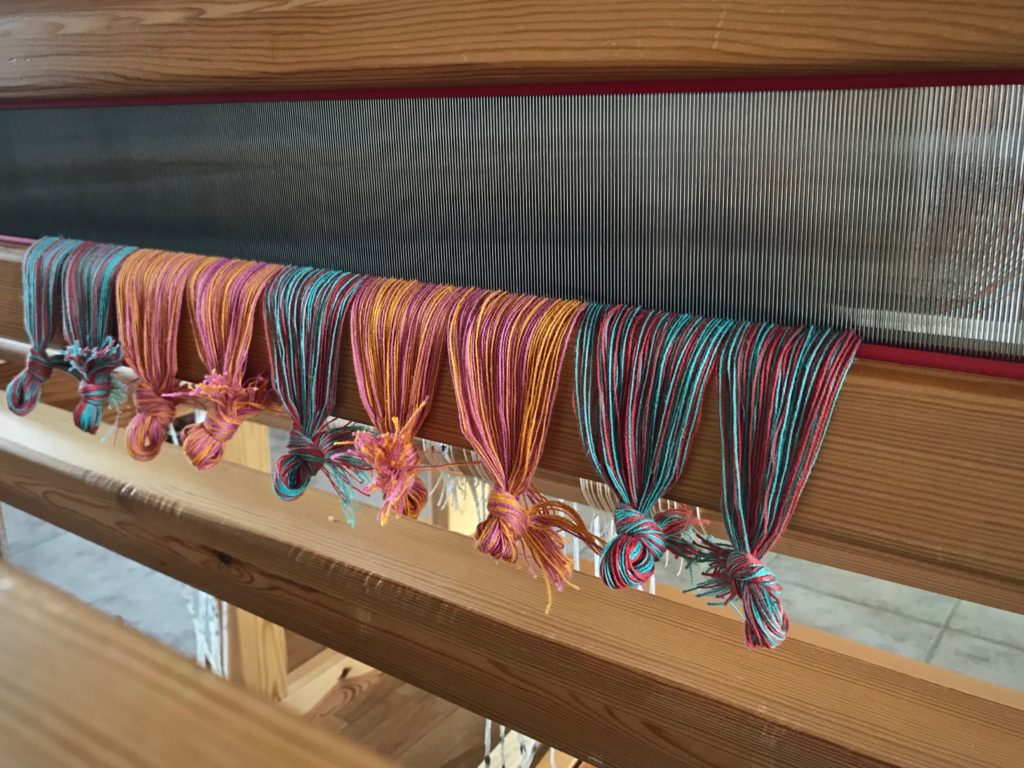It is not easy to see sleying errors in this fine-dent reed. I unknowingly quadrupled the ends in four of the dents, instead of the specified two ends per dent. When I check as I go, I find the errors while they are still easy to fix.
How to check and double-check for sleying errors:
- Tie ends into threading groups, using a loose slip knot. (I do this before threading the heddles.)
- Sley one threading group. (I sley right to left.)
- Visually check the sleyed group of ends for skipped dents and crowded dents.
- Do a Click Test. Use the hook end of the reed hook to count the dents by running the hook along the reed…click, click, click… Make sure the number of clicks matches the number of dents needed for that group of ends.
—This is how I caught my errors. When the dents came up short in the Click Test, I knew I had some crowded dents that I had failed to catch in the visual check. - Move ends and re-sley as needed.
- Sley each remaining group of ends, checking as you go, visually and with the reed-hook Click Test.

May your errors be few and fixable.
Happy sleying,
Karen

Great tips! I warp F2B, sley the reed left to right and the heddles right to left.
Hi Beth, No matter what warping method we use, it’s good to find any denting errors as soon as possible. After the weaving begins it’s much more of a hassle to correct, isn’t it?
Happy weaving,
Karen
Ouch. Better at the click than 10 rows into the weaving.
Thank you for the lesson to correct.
Nannette
Hi Nannette, Exactly! Find the mistakes early.
Happy weaving,
Karen
Hello Karen,
I have been following your work for many months, love your teaching and can’t wait for your next project.
Unfortunately I don’t get the clicking of a hook to check if skip or crowded reed. Is there a video or some kind of demo for me to learn from. I have some mistakes when I’m dressing the loom and it is frustrating when the skip or the crowing is right of the middle of the reed, if you know what I mean.
Lise
Hi Lise, That will be a good subject for a short video. Thanks for the suggestion. I can do that next time I dress the loom.
I do know what you mean about finding a denting error — and it always seems to fall right in the middle of the reed!
What I mean by the “click test” is this – I know that if I have 40 ends in a threading group, and there are 2 ends per dent, that there should be 20 dents with threads in them when I finish sleying that group of threads. I am counting the dents with the tip of the reed hook (it’s hard for me to count the dents without something touching the actual spaces, and my finger is too large for that with this fine-dent reed). As I move the reed hook along the reed, it makes a sound (“click”) at each dent. I listen for 20 “clicks” to check that I have those 40 threads in 20 dents.
I’m always looking for ways to check my work as I go so that when I get to the weaving part it’s smooth sailing! But even so, a few mistakes still manage to slip through sometimes. That’s weaving! But thankfully, mistakes are fixable!
I hope that makes sense.
Happy weaving,
Karen
Good morning, Karen.
I am also not sure what you mean by clicking the reed in terms of how that will show a mistake. Perhaps a short video in future when you need to sley again?
I like the colors in the warp that you are using! Is the yarn a variable one? Or did you mix colors thread by thread? And what are you making? Inquiring minds want to know.
Hi Annie, I’ll make a short video about the “click test” next time I dress the loom. Thanks for the suggestion!
Read my answer to Lise, and see if it makes sense to you.
The warp colors alternate. Since I wind with 2 threads at a time, I’m able to wind the 2 colors at the same time and then thread them alternately in the heddles.
I am making hand towels for my daughter. This is double weave with twelve shafts. (My first attempt at weaving with twelve shafts.)
Happy weaving,
Karen
I love how you are always challenging yourself and growing as a weaver. I can’t wait to see the progress on these towels. After reading your response to Lise, I understand the click test perfectly. I am going to adopt this practice also.
Thank you for taking the time to clarify for us.
Hi Annie, Oh good, I’m glad that helped!
All the best,
Karen